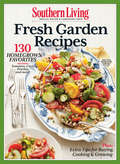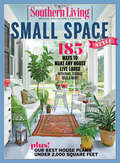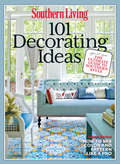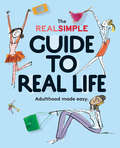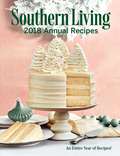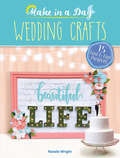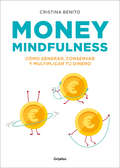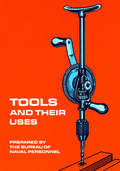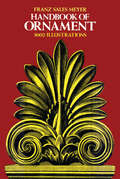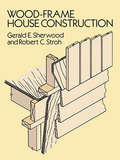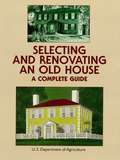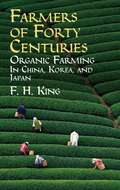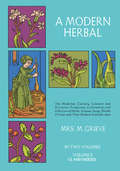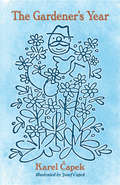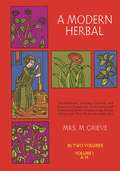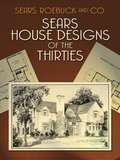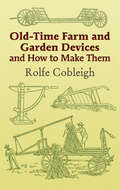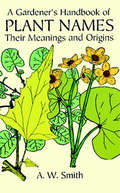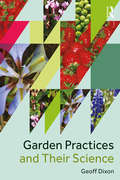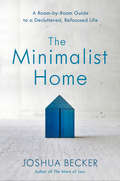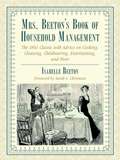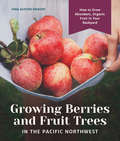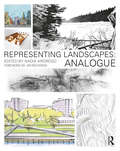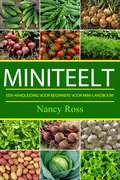- Table View
- List View
SOUTHERN LIVING Fresh Garden Recipes: 130 Homegrown Favorites
by The Editors of Southern LivingForget farm to table restaurants; Fresh Garden Recipes is your seasonal go-to guide that brings your garden harvest to your very own kitchen. <P><P>Whip up delectable dishes with the ripest, sweetest, zestiest, and juiciest fruits and vegetables that you and your family will turn to season after season. After all, everything tastes better fresh and homemade.Southern Living's new special edition, Fresh Garden Recipes, features 130 homegrown favorites including tomatoes, corn, peaches and more! <P><P>From Spring to Summer through Fall to Winter, the editors of Southern Living magazine have you covered with the freshest finds throughout the year to create the most savory dishes including Cream of Carrot Soup, Strawberry Mousse Cake, Pancetta and Fig Pasta, Zucchini and Spanish Lasagna, Crab Salsa with Peaches and Avocados, and even Honey-Suckle Cocktails. Enjoy!
SOUTHERN LIVING Small Space Style: 185 Ways to make Any House Live Large
by The Editors of Southern LivingDiscover the art of living small! If you think outside the box you can fit entertaining and living spaces into a tiny, tricky layout!
SOUTHERN LIVING 101 Decorating Ideas: The Ultimate Guide to Southern Style
by The Editors of Southern LivingSouthern homes have always been known for being warm and welcoming, whether a grand historic house or a small cottage or bungalow. Now the editors of Southern Living, the authority on all things Southern, bring you a special edition of Southern Living guaranteed to take your home style to the next level. Whether you're designing your dream living room from the hardwood floor up, or just tweaking the look of an entry hall or completely redoing the whole kitchen, Southern Living shares their favorite ideas and inspirations.Chock-full of expert advice, including how to mix color and pattern like a pro to the best ways to transform a flea market find, the tips and tricks included in 101 Decorating Ideas cover every room in the house and include a wide range of ideas--some that can be done by yourself and within a day, to larger projects that might require a little more time and assistance, but all with beautiful photography that will inspire you along the way and help you transform your home into a place you can't wait to get back to every day.
The Real Simple Guide to Real Life: Adulthood made easy.
by The Editors of Real Simple MagazineREAL SIMPLE, the #1 women's lifestyle magazine, shares the secrets to mastering "life 101"--from home to work to relationships--in this must-have, illustrated handbook to help young adults navigate their busy, new lives. Right after graduation, the questions start piling up. And they just keep on coming throughout your 20s and beyond: How do I find a job that I love--and, um that pays? What should I wear to the interview? And speaking of clothes, where do I put them when my apartment doesn't even have a closet? REAL SIMPLE created The Real Simple Guide to Real Life: Adulthood Made Easy to answer all of those questions--and so many more. Original essays from best-selling young writers and practical advice from expert contributors simplify (and demystify) landing a job, finding an apartment, decorating on the cheap, cooking for one, dressing for work, organizing a small space, picking a mentor, writing a thank-you note (yes, they're still a thing)--plus all the answers you need to deal with 401(k)s, kitchen fails, epic hangovers, messy roommates, and even messier breakups. Hear from these inspiring women and others about what they wish they had known when they were starting out: Gretchen Rubin, Barbara Corcoran, Rosie Schaap, Gail Simmons, Melinda Gates, Cristina Henríquez, Madeleine Albright, Doree Shafrir, Camille Styles, Egypt Sherrod, Kelly Wearstler, Brené Brown, Edan Lepucki, Abby Larson, Emmy Rossum, Jenni Konner, Jessica Alba, Molly Antopol, Anna Holmes, Rachel Sklar, and J. Courtney Sullivan.
Southern Living 2018 Annual Recipes: An Entire Year Of Cooking
by The Editors of Southern LivingFor over half a century, Southern Living has been the South's most trusted source for the recipes, entertaining ideas, and traditions that reflect the soul of the region. ENJOY MORE THAN 550 RECIPES YOU CAN COUNT ON for everyday meals, portable party nibbles, mouthwatering main dishes, and decadent desserts from the South's most trusted kitchen.
Make in a Day: Wedding Crafts (Make in a Day)
by Natalie WrightIt's one of the most important days of your life. Or it's the wedding of your dear friend or a beloved family member — what can you do to help make it as memorable and personal as possible? Add a graceful and unique touch to the celebration with handcrafted decorations and keepsakes! This practical guide will show you how to quickly and easily create a terrific variety of ornaments: a centerpiece, guest gift, tablescape, and more. You don't need any crafting experience for these easy projects, and best of all, they can be completed in less than a single day.Each book in Dover's Make in a Day series presents 15 projects with illustrated step-by-step instructions. The beginner-friendly projects are ideal for anyone wishing to whip up something simple but special. Supplies are easy to find and are readily available at major craft stores. Other titles in the series include Make in a Day: Modern Wreaths, Make in a Day: Pompom Crafts, Make in a Day: Paper Flowers, Make in a Day: Garlands, and Make in a Day: Centerpieces.
Sears Modern Homes, 1913 (Dover Architecture Ser.)
by Co. Roebuck SearsFor thousands of Americans, catalogs such as Sears' Modern Homes were the first step in realizing their dreams of owning a home. Reproduced from a rare 1913 edition, this volume features 112 designs for homes of "comfort and refinement." These authentic plans offer a wealth of information on building materials and other details, along with external views, floor plans, descriptions with prices, and more. Antique collectors, home hobbyists, and fans of traditional design will find this book a bountiful resource for valuable tips on building and restoration.
Money Mindfulness
by Cristina Benito GrandeAprende a ser consciente de tu dinero para usarlo de manera eficaz. Con un método revolucionario que aúna el Mindfulness y los secretos de los hombres y mujeres de negocios más exitosos del mundo, aprenderemos a generar, conservar y multiplicar nuestro dinero, sean cuales sean nuestros ingresos, para que nunca más sea un problema. Para cualquiera que aplique una pequeña parte de lo que se revela en Money Mindfulness, lo que haya pagado por este libro será la mejor inversión de su vida.
Tools and Their Uses
by U.S. Bureau of Naval PersonnelDo you have trouble with tools — find that they wear out too quickly, find that you can't decide which tools to buy or which tools to use for a specific job, find that little things continually go wrong? The only way to learn to use tools, of course, is by using them, but first you have to know which tools to use and why.This manual, originally prepared for the use of naval personnel, was designed to present the basic hand and power tools that the ordinary person is likely to use. Through a wealth of diagrams, clear explanations, safety tips, and operating instructions you will soon learn the basics of choosing tools and using them as they were meant to be used. Nearly every hand tool you are likely to use around the house is described in the first chapter: hammers, wrenches, screwdrivers, wood saws, planes, wood chisels, metal chisels, dies, drills, files, hacksaws, punches, reamers, taps, clamps, vises, pliers, knives. Chapter two covers the common power tools: drills, grinders, sanders. Chapter three covers measuring tools from rules and tapes to calipers, micrometers, and squares with detailed instructions on how to use each one. Chapter four describes the common nails, screws, bolts, nuts, rivets, and other fasteners you are likely to use. Chapter five describes grinders and shows how to sharpen and care for screwdrivers, chisels, drills, and snips. The final two chapters cover such miscellaneous tasks and tools as metal cutting operations, stripping insulated wire, and soldering techniques.By the time you finish you should know the names, general uses, and correct operation of all the basic tools, fasteners, and measuring devices you are likely to need around the house. You should be able to select tools for a basic kit for doing simple home repairs. And you should be confident in beginning to use tools for yourself to perform all those simple but necessary repair jobs.
Handbook of Ornament: A Grammar Of Art, Industrial And Architectural Designing In All Its Branches, For Practical As Well As Theoretical Use (classic Reprint) (Dover Pictorial Archive Ser.)
by Franz Sales MeyerRepublished unabridged from the final comprehensive edition, this work contains the largest single-volume collection of classical art motifs ever compiled. It reproduces material from Greek and Roman, medieval European, Islamic, Renaissance, baroque, and early nineteenth-century art, architecture, and design — in all, presenting artists, crafters, and students with more than 3,000 designs.Featured design elements include networks, Gothic tracery, geometric designs, akanthos leaves, lotus ornamentation, animal ornamentation, grotesque figures, fret bands, chains, interlacements, rosettes, undulations, spirals, link borders, cresting borders, finials, crockets, gargoyles, foliations, panels, repeated ornaments, and hundreds of other elements. Other plates show decorated pottery vases, religious utensils, weapons, furniture, lamps, jewelry, and other artifacts, in addition to heraldic motifs and ornamental letters.
Wood-Frame House Construction: A Do-it-yourself Guide
by Gerald E. Sherwood Robert C. StrohFirst published in 1955 as U.S. Department of Agriculture Handbook No. 73, this highly popular guide presents sound, time-tested principles for wood-frame house construction, complete with expert advice on selecting suitable building materials. For this edition, it has been completely revised and updated to incorporate advances in home building brought about by the availability of new materials, use of more manufactured components, and changes in construction techniques. Chapter 1 covers the preliminaries that should be considered or dealt with before beginning construction ― financial planning, site selection, design, etc.Chapters 2–4 discuss laying the groundwork (including foundations, footings, and retaining walls), framing and closing in ― describing each step in the order it is usually completed. Chapters 5–7 describe later tasks that don't necessarily have to be done in the order they are presented. Topics include porches, decks, interior wall framing, plumbing, heating and electric installation, flooring, interior finishes, cabinets, and more. Chapter 8 covers special topics often associated with wood-frame construction: protection against decay and termites, energy conservation, all-weather construction, maintenance and repair, and other matters. Technical notes, an annotated list of suggestions for additional reading, and a glossary round out the book. Clear, thorough, and easy to follow, with nearly 200 helpful illustrations, Wood-Frame House Construction offers a detailed, informative guide to construction techniques invaluable for the do-it-yourselfer or as a review for the professional.
Selecting and Renovating an Old House: A Complete Guide
by U.S. Dept. of AgricultureClear, thoughtfully written manual tells how to appraise worthiness of an older home, develop plans for remodeling the kitchen, adding a bath, replacing floors, roof, windows, doors, interior walls, kitchen cabinets, and much more. Full glossary of housing terms and 157 illustrations clarify an extremely detailed text.
Farmers of Forty Centuries: Organic Farming in China, Korea, and Japan
by F. H. KingFor more than 40,000 years, Asian farmers worked the same fields repeatedly without sapping the land's fertility and without applying artificial fertilizer! How they accomplished this miraculous feat is described by author Franklin Hiram King, a former official of the U.S. Department of Agriculture. King traveled to Asia in the early 1900s to learn how farmers in China, Korea, and Japan were able to achieve successful harvests century after century without exhausting the soil — one of their most valuable natural resources. This book is the result of his extraordinary mission.A fascinating study of waste-free methods of cultivation, this work reveals the secrets of ancient farming methods and, at the same time, chronicles the travels and observations of a remarkable man. A well-trained observer who studied the actual conditions of life among agricultural peoples, King provides intriguing glimpses of Japan, China, Manchuria, and Korea; customs of the common people; the utilization of waste; methods of irrigation, reforestation, and land reclamation; the cultivation of rice, silk, and tea; and related topics.Enhanced with more than 240 illustrations (most of them photographs), this book represents an invaluable resource for organic gardeners, farmer, and conservationists.
A Modern Herbal: Vol. II
by Margaret GrieveIf you want to know how pleurisy root, lungwort, and abscess root got their names, how poison ivy used to treat rheumatism, or how garlic guarded against the Bubonic Plague, consult A Modern Herbal. This 20th-century version of the medieval Herbal is as rich in scientific fact and folklore as its predecessors and is equally encyclopedic in coverage. From aconite to zedoary, not an herb, grass, fungus, shrub or tree is overlooked; and strange and wonderful discoveries about even the most common of plants await the reader.Traditionally, an herbal combined the folk beliefs and tales about plants, the medicinal properties (and parts used) of the herbs, and their botanical classification. But Mrs. Grieve has extended and enlarged the tradition; her coverage of asafetida, bearberry, broom, chamomile, chickweed, dandelion, dock, elecampane, almond, eyebright, fenugreek, moss, fern, figwort, gentian, Hart's tongue, indigo, acacia, jaborandi, kava kava, lavender, pimpernel, rhubarb, squill, sage, thyme, sarsaparilla, unicorn root, valerian, woundwort, yew, etc. — more than 800 varieties in all — includes in addition methods of cultivation; the chemical constituents, dosages, and preparations of extracts and tinctures, unknown to earlier herbalists; possible economic and cosmetic properties, and detailed illustrations, from root to bud, of 161 plants.Of the many exceptional plants covered in Herbal, perhaps the most fascinating are the poisonous varieties — hemlock, poison oak, aconite, etc. — whose poisons, in certain cases, serve medical purposes and whose antidotes (if known) are given in detail. And of the many unique features, perhaps the most interesting are the hundreds of recipes and instructions for making ointments, lotions, sauces, wines, and fruit brandies like bilberry and carrot jam, elderberry and mint vinegar, sagina sauce, and cucumber lotion for sunburn; and the hundreds of prescriptions for tonics and liniments for bronchitis, arthritis, dropsy, jaundice, nervous tension, skin disease, and other ailments. 96 plates, 161 illustrations.
The Gardener's Year (Modern Library Gardening Ser.)
by Karel Capek Josef CapekThe creator of this book is best known internationally as the author of R.U.R., the science-fiction play that introduced the term "robot" to the world. Karel Čapek's satiric gifts take a different turn in this impishly comic book, which recounts the trials, labors, joys, and meditations of the amateur gardener.Rather than a how-to book, Čapek's volume offers a lighthearted mock-treatise on the pains and rewards of tending a small and resistant garden plot. From January to December, the author and his brother, illustrator Josef Čapek, trace the vagaries of the amateur horticulturist's year, with brief side notes on seeds, the soil, plants, the beauties of autumn, and other aspects of gardening. Fifty-nine delightful drawings complement this book, which will amuse readers with and without green thumbs.
A Modern Herbal
by Margaret GrieveIf you want to know how pleurisy root, lungwort, and abscess root got their names, how poison ivy used to treat rheumatism, or how garlic guarded against the Bubonic Plague, consult A Modern Herbal. This 20th-century version of the medieval Herbal is as rich in scientific fact and folklore as its predecessors and is equally encyclopedic in coverage. From aconite to zedoary, not an herb, grass, fungus, shrub or tree is overlooked; and strange and wonderful discoveries about even the most common of plants await the reader.Traditionally, an herbal combined the folk beliefs and tales about plants, the medicinal properties (and parts used) of the herbs, and their botanical classification. But Mrs. Grieve has extended and enlarged the tradition; her coverage of asafetida, bearberry, broom, chamomile, chickweed, dandelion, dock, elecampane, almond, eyebright, fenugreek, moss, fern, figwort, gentian, Hart's tongue, indigo, acacia, jaborandi, kava kava, lavender, pimpernel, rhubarb, squill, sage, thyme, sarsaparilla, unicorn root, valerian, woundwort, yew, etc. — more than 800 varieties in all — includes in addition methods of cultivation; the chemical constituents, dosages, and preparations of extracts and tinctures, unknown to earlier herbalists; possible economic and cosmetic properties, and detailed illustrations, from root to bud, of 161 plants.Of the many exceptional plants covered in Herbal, perhaps the most fascinating are the poisonous varieties — hemlock, poison oak, aconite, etc. — whose poisons, in certain cases, serve medical purposes and whose antidotes (if known) are given in detail. And of the many unique features, perhaps the most interesting are the hundreds of recipes and instructions for making ointments, lotions, sauces, wines, and fruit brandies like bilberry and carrot jam, elderberry and mint vinegar, sagina sauce, and cucumber lotion for sunburn; and the hundreds of prescriptions for tonics and liniments for bronchitis, arthritis, dropsy, jaundice, nervous tension, skin disease, and other ailments. 96 plates, 161 illustrations.
Sears House Designs of the Thirties (Dover Architecture Ser.)
by Co. Roebuck SearsProudly promoting itself as "the largest home building organization in the world," Sears, Roebuck and Company advertised in 1932 products in a handsome catalog that also displayed a full-size replica of Mount Vernon, created from Sears materials for a Paris exposition in 1932.At the heart of this now-rare publication were measured floor plans for 68 Sears homes. Over 200 illustration displayed interiors and exteriors for such handsome residences as the Belmont, a six-room house with vestibule, breakfast alcove, three bedrooms, and one-and-a-half baths; and the Dover, an English-styled cottage with a massive chimney and unusual roof lines. Photographs of some interiors revealed a furnished living room with paneled side walls and hewed oak ceiling beams; a spacious kitchen with contemporary appliances; a 60-foot living room with a huge stone fireplace, built-in bookshelves, a vaulted ceiling, and other designs.An invaluable sourcebook for restorationists, this handsome volume will also be of use to people interested in preserving homes of the period. It will be welcomed by anyone who relishes a glimpse of America's architectural past.
Old-Time Farm and Garden Devices and How to Make Them
by Rolfe CobleighA splendid bit of rural Americana, Cobleigh's book shows how anyone with a little time and money can add a touch of authentic charm to their farm, house, or garden. First published nearly a century ago, this practical guide features dozens of projects, accompanied by some 200 illustrations. A simply written text not only tells how to mount an anvil, make a cheese press, and build hog houses, but also provides handy advice on splitting wood, testing seed corn, tying practical knots, sharpening scissors, and papering a room.From building a rose trellis to creating a bicycle-powered washing machine, readers will delight in this book’s abundance of enjoyable and useful projects. It’s perfect for novice craftworkers and die-hard fans of Yankee ingenuity.
A Gardener's Handbook of Plant Names: Their Meanings and Origins
by A. W. SmithFirst compact dictionary to combine definitions of botanical names in general usage with information on their derivation and guides to pronunciation. A monumental index provides a cross-reference from some 1,800 common plant names to corresponding botanical ones. Combines thoroughness, botanical rigor, and interesting facts and lore — all leavened with touches of humor.
Garden Practices and Their Science
by Geoff DixonWritten in a clear and accessible style, Garden Practices and Their Science guides gardeners in the practical arts of plant husbandry and in their understanding of its underpinning principles. The author, Professor Geoff Dixon, is an acknowledged and internationally respected horticulturist and microbiologist; he intertwines these arts and principles carefully, expertly leading readers from one to the other. Achieving the manipulation of plant life is described in eight full-colour, well-illustrated chapters covering the growing of potatoes, bulb onions, legumes, small-seeded vegetables, soft fruit, bulbs and herbaceous ornamentals in great detail. Environmental factors controlling the successful husbandry of these crops is described in simple, non-technical language, increasing gardeners’ enjoyment and competence. Gardeners are also informed of the tools and equipment they require and their safe use. Also provided are a series of simple, straightforward tests identifying the aerial and soil environments beneficial for plant growth using readily accessible domestic tools. Discussions of very straightforward techniques for vegetative propagation conclude this book. Each chapter ends with a list of the gardening knowledge that has been gained by readers. The structure of this book fulfils a longstanding need for descriptions of practical skills integrated with the corresponding biological reactions of plants. Emphasis is placed on gardeners’ development of healthy soils, which encourage vigorous, active root systems capable of withstanding stresses—an aspect of gardening that rarely receives sufficient attention. Tailored for readers requiring clear and concise directions, this very practical book is an instruction manual directed at early-stage gardening learners. These include people of all ages and requirements such as new garden owners, allotment-holders, apprentices and students of basic levels in the Royal Horticultural Society’s or City & Guilds qualifications, career changers, community gardeners and those needing applied biological knowledge for GCSE examinations.
The Minimalist Home: A Room-by-Room Guide to a Decluttered, Refocused Life
by Joshua BeckerA popular minimalist blogger and author of The More of Less shows you how to methodically turn your home into a place of peace, contentment, and purposeful living.One of today's most influential minimalist advocates takes us on a decluttering tour of our own houses and apartments, showing us how to decide what to get rid of and what to keep. He both offers practical guidelines for simplifying our lifestyle at home and addresses underlying issues that contribute to over-accumulation in the first place. The purpose is not just to create a more inviting living space. It's also to turn our life's HQ--our home--into a launching pad for a more fulfilling and productive life in the world.
Mrs. Beeton's Book of Household Management: The 1861 Classic with Advice on Cooking, Cleaning, Childrearing, Entertaining, and More (Cassell Value Ser.)
by Sarah A. Chrisman Isabella BeetonOriginally published as twenty-four newspaper columns from 1859 to 1861, Mrs. Beeton’s Book of Household Management is many things, but it is first and foremost a guide to managing a household during the nineteenth century. Beeton wrote, "As with the commander of an army, or the leader of any enterprise, so is it with the mistress of a house. ” Running an extravagant household was a monumental task and a responsibility not to be taken lightly. It meant supervising every employee, from the butler to the laundry-maid to the footman and the wet nurse. It meant managing the safety, happiness, comfort, and well-being of the family. In addition to offering advice on a wide range of domestic topics, this abridged edition of Mrs. Beeton’s Book of Household Management contains hundreds of original recipes. A compendium of practical information about everything from animal husbandry to child care, this Victorian classic is both fascinating and still useful. Sarah A. Chrisman, author of Victorian Secrets and This Victorian Life provides the foreword, reflecting on how she uses Mrs. Beeton’s advice on a daily basis.
Growing Berries and Fruit Trees in the Pacific Northwest: How to Grow Abundant, Organic Fruit in Your Backyard
by Tara Austen WeaverA beautiful guide to growing delicious fruit in Pacific Northwest climates, complete with selection, planting, and organic care for more than 75 cultivars of berries and fruit trees, as well as 10+ master recipes with variations for preserving your bountiful harvest.This complete guide to backyard fruit growing covers recommended varieties and climate info for the Pacific Northwest both west and east of the Cascades, ideal climates for growing berries and fruit trees. Also includes sidebars showcasing historical orchards, fruit enthusiast societies, gleaning organizations, and more. Includes several recommended cultivars of each of the following types of fruit: -Berries: strawberries, raspberries, blueberries, blackberries, kiwi berries, plus less common berries such as lingonberries, elderberries, currants, gooseberries, jostaberries, and a section on wild berries. -Fruit trees: apples, pears, Asian pears, cherries, peaches, nectarines, apricots, plums, plus less common fruit trees such as figs, persimmons, and quince.
Representing Landscapes: Analogue (Representing Landscapes)
by Nadia AmorosoThe fourth book in Nadia Amoroso‘s Representing Landscapes series, this text focuses on traditional methods of visual representation in landscape architectural education. Building on from the previous titles in the series, which look at digital and hybrid techniques, Representing Landscapes: Analogue is a return to the basic foundations of landscape architecture’s original medium of visual communication. Each of the 20 chapters includes contributions from leading professors teaching studio and visual communication courses from landscape architecture programs across the globe, showcasing the best student examples of analog techniques. It demonstrates the process from graphics as a form of research, design development, and analysis, to the final presentation through drawings, models and descriptive captions of the methods, styles and techniques used. It features critical and descriptive essays from expert professors and lecturers in the field, who emphasise the importance of the traditional medium as an intrinsic part of the research, design and presentation process. Over 220 full colour images explore the range of visual approaches students and practitioners of landscape architecture can implement in their designs. With worked examples in the chapters and downloadable images suitable for class use, this is an essential book for visual communication and design studios.
miniteelt: een handleiding voor beginners voor mini-landbouw
by Nancy RossWil je de basis van mini-landbouw leren? Of je nu mini-landbouw wilt leren voor tuinieren, vee of zelfvoorziening, dit boek zal helpen! Hier is een voorbeeld van wat u zult leren ... Simpele trucs om je ruimte te maximaliseren Beste planten voor Mini Farming De juiste grond kiezen Ongediertebestrijding Het verzorgen van onkruid Vee dat het goed doet met minifarming? Tips om mini-farming gemakkelijker te maken Veel, veel meer!
